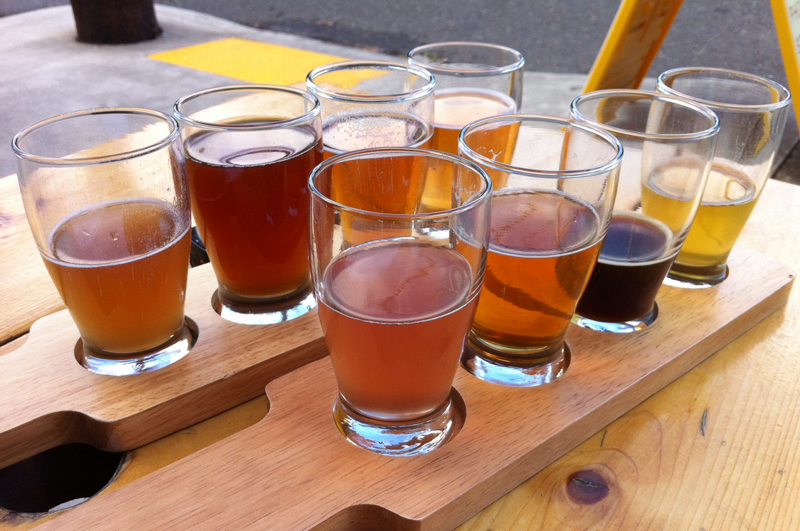Found Ingredients: Beers Made By Walking

A flight of beers from the Beers Made By Walking project at Belmont Station in Portland, OR. Photo by Jeff Alworth.
Artemisia douglasiana, also known as California mugwort, grows along stream banks up and down the West Coast. Dried and—particularly—burned, it has a distinctive aroma similar to another plant famous in the region, Cannabis sativa. Perhaps for this reason, it creates a pungent, hop-like quality when added to the conditioning tank of a light ale. The flavor is anything but subtle; it is sticky and musky and surprisingly bitter, reminiscent of some of the more exotic modern hops in vogue. I discovered it in a gluten-free beer by Portland’s Ground Breaker Brewing, the result of a project called Beers Made By Walking in which brewers go out and forage for local ingredients they later use in a beer.
For 90 percent of the 10,000 years or so that humans have been making beer, this is how they brewed: making it from whatever they could scratch from the earth. With all the focus on “hand-crafted beer” of late, we have forgotten what an intensely industrial process brewing has become. Ingredients are grown and processed hundreds or thousands of miles away and shipped to brewers on diesel-powered trains. Yeast is maintained in laboratories. Water is treated with minerals. Brewhouses are fabricated of steel, use industrial plumbing and wiring, and require enormous amounts of energy to run. Hops and malt from around the world are available with a phone call, and brewers have next to no idea how they’re grown. It is a process far removed from farmhouse brewers who once grew everything they needed right on their own land.
Using local ingredients is a way of getting back to an earlier spirit of brewing. There’s a current trend toward place-based brewing, but it usually just means trying to source local(ish) barley and hops. Beers Made By Walking counts as a further step, a rediscovery of something closer to indigenous brewing or, in the words of founder Eric Steen, creating beers that are “drinkable portraits of a landscape.” Eric has led hikes in Colorado and the Northwest; through urban forests, up 14,000-foot mountains, into arid canyons—anywhere that might give brewers inspiration.

Eric Steen is the founder of Beers Made By Walking, in which brewers forage for ingredients to include in their beer. Photo by Jeff Alworth.
Over the summer, Eric led brewers on hikes around Oregon, and a couple of weeks ago, he debuted sixteen of the beers made for the project. I’ve long been fascinated by indigenous beers and wondered—could anything growing around here ever come to be seen as traditional as, say, lambic beers made with native yeasts? For an industry that thrives on the twin values of novelty and localness, this is a perfect question for the moment. The Oregon beers were promising enough to suggest the answer to the question may be yes. To highlight the point, let me draw your attention to three intriguing ingredients.
The first is not exactly unknown to brewers: spruce. In the spring, Sitka Spruce trees—one of the majestic giants of the rainforests—grow pale green, tender tips. A native food source, they are also a versatile ingredient in beer and can be used entirely in place of hops, as Astoria’s Fort George Brewery did with Spruce Budd, which was akin to a kölsch. Curiously, they’re tips aren’t piney. They contribute a sweet, tart, honey-like flavor and also the slight waxiness of honey. Rich with Vitamin C, they can also lend citrus flavors. If you served this beer to people on a hot, summer day, I don’t think they would notice it had no hops. It didn’t taste weird or “herbal”—just zingy, crisp, and refreshing.
The next success involved yeast. Eric and his brewers collected wild strains from six sites in a Douglas Fir forest using fresh wort. Thunder Island Brewing from Cascade Locks used those yeasts in a stout called Sour Darkness—and didn’t pitch anything else. The beer was remarkably mild, with acidity at about the level of red wine. In fact, it gave more fruit (blackberry jam) than tartness, and no Bretty flavors. It was perfectly gentle and would have been welcome by any beer fan, not just wild ale fans.
The biggest revelation, though, was an IPA by Portland’s Burnside Brewing that had been aged on blocks of cedar wood. The western red cedar (Thuja plicata) has long been the most important tree to native peoples of the Pacific Northwest—it was once called a “canoe cedar,” but was used for totem poles and wood lodges, too—in large part because it contains an aromatic, oily compound called thujaplicin. For years I have wondered what a beer aged on cedar would taste like; if American oak is thought to be intense, what about thuja plicata? Wow. It is quite an experience—a deep, back-of-the-throat oiliness that coats the tongue like varnish, deeply woody and cedary. It’s not the kind of flavor that would work with every beer; Burnside was wise to use it with a resinous, hoppy ale and in Cedar IPA, it was spectacular.
Desert sagebrush (Artemisia tridentate), sorrel (Oxalis oregana), and salal berry (Gaultheria shallon) were all also very promising, though working with native ingredients is unpredictable. Mugwort may be as strong as Mosaic hops, but most wild herbs aren’t. They’re subtle. I searched in vain to locate the flavors of meadowsweet, berry flower, and yarrow in beers that used them. As Eric pointed out, finding an interesting-smelling plant doesn’t mean you know what to do with it. “When you go on a hike and you try cedar and take a little nibble, it doesn’t give you the best sense of how it’s going to taste in the beer. If you age it on cedar wood, or add tips to the mash, or add the tips to the end of the boil—it’s not the same thing. The brewers are thinking about those things.”
Might one of these ingredients become a fixture in local brewing? Eric hedged, acknowledging that oddball ingredients aren’t about to replace hops or turn Oregon into a spruce-beer state. But some ingredients might become regulars. “Spruce is one of those ingredients that gives really good results. Juniper, which has been used in indigenous beers, can be mind-blowing. Sage, for its aromatic qualities.”
I’d go a step further: I wouldn’t be surprised to find one or more of these ingredients become as necessary to certain types of beer as coriander and orange peel are to witbier. If so, those beers would necessarily be tied to the region. And that’s just the Pacific Northwest. There are a dozen biogeographic regions in the United States and hundreds of ecosystems, each rich with local flora ripe for the brewer’s picking. It’s a long-term prospect, but one that is already underway. And of all the competing trends within brewing, one of the most interesting.
Read more posts from The Beer Bible Blog.
Jeff Alworth is the author of the forthcoming book, The Beer Bible (Workman, 2015). Follow him on Twitter or find him at his blog, Beervana.

If you’re interested in another cedar aged beer, up in Vancouver (BC) Central City and Four Winds Brewing released a collab cedar aged pale about a month that was also really cool. If you can get your hands on it, it’s worth a try!
Great article. Thank you!
Braeden, on the off chance I font make it up there, what’d it taste like? Did you find the cedar to be as pronounced as it was in the Burnside IPA?
Two beers–that’s almost a trend, right?!
Jeff,
I found that the hops and cedar came through pretty evenly in the aroma, which was rather enticing. Upon tasting it, the west coast hops (I’m thinking amarillo) came up first with some big grapefruit flavours(Canadian spelling for a Canadian beer, eh?), and slowly as the beer went on, the cedar’s distinct oily flavour came through. It was definitely noticeable, but also nicely balanced with everything else.
Font=don’t. Sorry–
I once had a homebrew made with a favorite local PNW ingredient: chanterelle mushrooms, cooked first then added in big quantities during secondary fermentation. The base ale was gentle with low bitternes; mushroom flavor was subtle, but it was delicious beer.
I have a homebrew buddy of mine who made a tripel, and infused it with chanterelles by soaking raw chanterelles in a bit of moonshine for a month, and adding in the infused moonshine post fermentation. Tasted awesome! I also had a buddy use the same technique infusing his pumpkin pear wheat beer, with a similar kick ass effect!